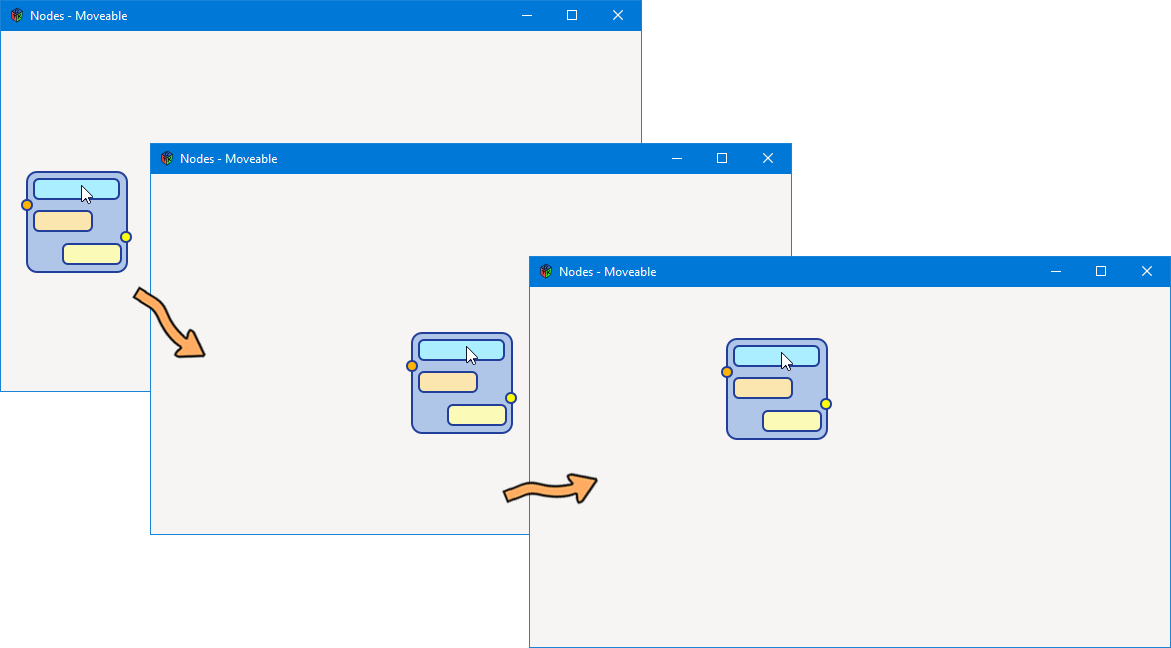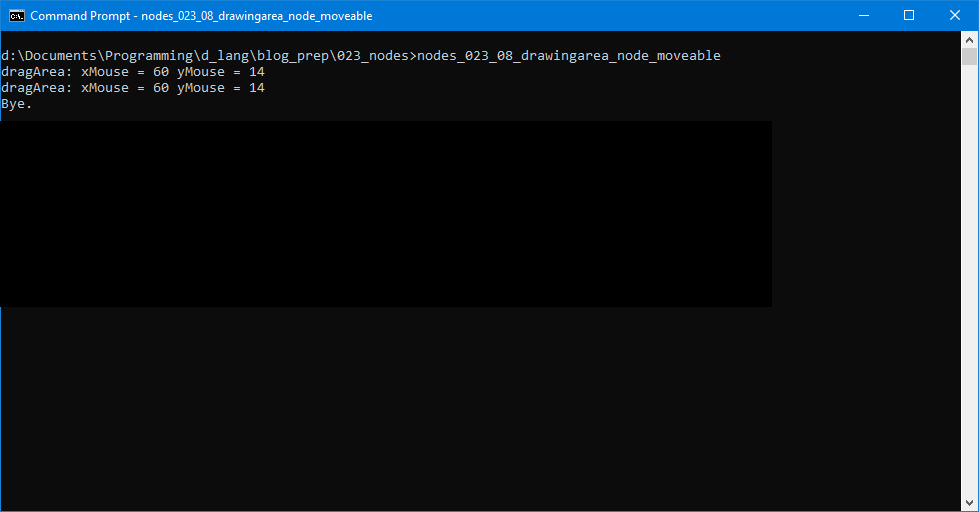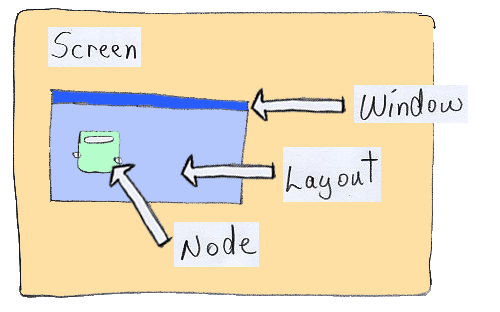0088: Nodes-n-noodles VII – It’s Alive!
Are you ready to move a node?
Yeah, me, too.
The Moveable Node


Again, we have to add some new statements in the MoveableNode class’s preamble and constructor, but our list of changes doesn’t stop there. We also need to add a couple of other functions and doctor every callback we’ve got so far. On top of that, we have to go up a level, class-wise, and make changes to the NodeLayout as well.
So to start with, let’s look at that…
Setting Up the NodeLayout for Moving Nodes
In each nodes-n-noodles demo until now, the initial position of the node was hard-coded in the NodeLayout’s constructor like this:
put(moveableNode, 20, 140);
But if we’re working toward—eventually—adding nodes as we go, we’ll want to move the MoveableNode’s position into the MoveableNode class where it belongs. But-but… at this experimental stage, that would be awkward because we’d have to instantiate the MoveableNode, then use a getter to grab its location info before we could place it within the NodeLayout. So for now, let’s throw caution to the wind and just move the node’s initial position into the NodeLayout’s preamble where we can still get at it easily, thus leaving proper encapsulation for a later stage of development:
class NodeLayout : Layout
{
MoveableNode moveableNode;
int[] _initialXY = [20, 140];
this()
{
super(null, null);
setSizeRequest(640, 360); // has to be set so signals get through from child widgets
moveableNode = new MoveableNode(this);
put(moveableNode, _initialXY[0], _initialXY[1]);
moveableNode.setPosition(_initialXY[0], _initialXY[1]);
} // this()
void moveNodeTo(MoveableNode moveableNode, double x, double y)
{
move(moveableNode, cast(int)x, cast(int)y);
moveableNode.setPosition(x, y);
} // moveNodeTo()
} // class NodeLayout
Okay, that works. The _initialXY array will store the node’s starting position and sometime down the road we’ll deal with varying this initial position, perhaps by having new nodes appear attached to the mouse pointer so they can be placed wherever the user wants. Sounds like a plan, but for now, this’ll do.
Another thing we have to do is grab a pointer to the NodeLayout and pass it to the MoveableNode. Why? So we have access to NodeLayout.moveNodeTo() because that’s how we’ll define the MoveableNode’s position in relation to the NodeLayout. We haven’t even talked yet about how we’ll tell the NodeLayout where the MoveableNode is and it’s a bit tricky because the x/y coordinates of the mouse pointer we’ve been working with so far have been in relation to the upper-left corner of the MoveableNode, not the NodeLayout.
It may have crossed your mind, too, that we talked about xRoot and yRoot last time and that these values might be of some help. But, no. Those variables record the offset from the upper-left corner of the Screen which is two levels up the hierarchy as can be seen here:

And this means, in order to move the MoveableNode around within the NodeLayout, we need to translate the mouse pointer position from MoveableNode coordinates to NodeLayout coordinates. Not that it’s difficult—just mind-bending—and we’ll get to that in a moment. All you need to keep in mind for now is that NodeLayout.moveNodeTo() makes the actual move happen and is called from MoveableNode.onMotionNotify(). And after the move is made, moveNodeTo() reaches back into the MoveableNode to update its position there.
Which, unfortunately, makes these two classes tightly coupled, but considering that we likely won’t use one without the other… we just might find a way to live with that.
Now, let’s look at the changes in the MoveableNode class.
MoveableNode Changes
First, here’s what we’re adding to the preamble:
double _xOffset = 0, _yOffset = 0;
bool _dragOn = false;
bool _connectToIn = false, _connectToOut = false;
double[] _nodePosition;
int _xIndex = 0, _yIndex = 1; // indices into the _nodePosition array
NodeLayout _nodeLayout;
In the very first line, we’re preparing to translate from MoveableNode coordinates to Layout coordinates. When the user clicks anywhere on the MoveableNode, these two variables, _xOffset and _yOffset, will record where in relation to the node’s origin (upper-left corner) the mouse pointer was at the time of the click.
Next we have _dragOn, a mode flag that gets raised when we want the MoveableNode to move and lowered when we want it to stay put. More on this in a moment.
The next two variables, _connectToIn and _connectToOut, are also mode flags—not used at this time—but as we progress toward a fully-functional nodes-n-noodles demo, we’ll be using them when we make connections between nodes. For now, they’re just there to show that we’re taking these things into account.
The _nodePosition array will keep track of the MoveableNode’s x/y coordinates on the NodeLayout and the next two, _xIndex and _yIndex, are here for clarity (rather than accessing the array as _nodePosition[0] and _nodePosition[1], we do it with _nodePosition[_xIndex] and _nodePosition[_yIndex]).
And finally, _nodeLayout is a pointer to the MoveableNode’s parent container.
Changes to the MoveableNode’s Constructor
The first significant change here is the line:
setEvents(EventMask.POINTER_MOTION_MASK | EventMask.BUTTON1_MOTION_MASK);
In order to separate mouse movement in two states—mouse button held down and mouse button not held down—we need to add these two signal masks. Without them, every movement of the mouse pointer will move the node, whether we’re holding a mouse button down or not.
Further down, we hook up the extra signals/callbacks we’ll need to properly process all this activity, bringing our total up to four connected signals:
addOnDraw(&onDraw);
addOnButtonPress(&onButtonPress);
addOnButtonRelease(&onButtonRelease);
addOnMotionNotify(&onMotionNotify);
As mentioned before, the processing of each node movement is done in three stages:
- in
onButtonPress(), we figure out what was clicked and set the active flag for the appropriate area: node handle, in terminal, or out terminal, - in
onMotionNotify(), we figure out which direction the mouse pointer is moving and do the appropriate math to translate from node coordinates toLayoutcoordinates (this is so theMoveableNodecan beput()in the right place on theNodeLayout), and lastly, - in
onButtonRelease(), we turn off the active flag so we know we’re finished with whatever activity we were carrying out: moving the node or connecting one of the terminals.
Conclusion
Because there’s so much to this node movement stuff, let’s stop here for now and pick up next time by looking at a handful of new functions needed to make this whole thing work.
Until then…
Comments? Questions? Observations?
Did we miss a tidbit of information that would make this post even more informative? Let's talk about it in the comments.
- come on over to the D Language Forum and look for one of the gtkDcoding announcement posts,
- drop by the GtkD Forum,
- follow the link below to email me, or
- go to the gtkDcoding Facebook page.
You can also subscribe via RSS so you won't miss anything. Thank you very much for dropping by.
© Copyright 2024 Ron Tarrant
